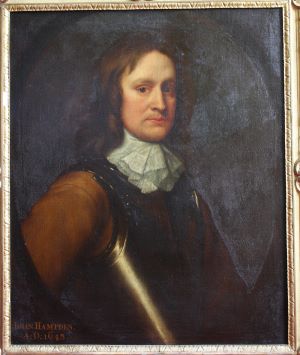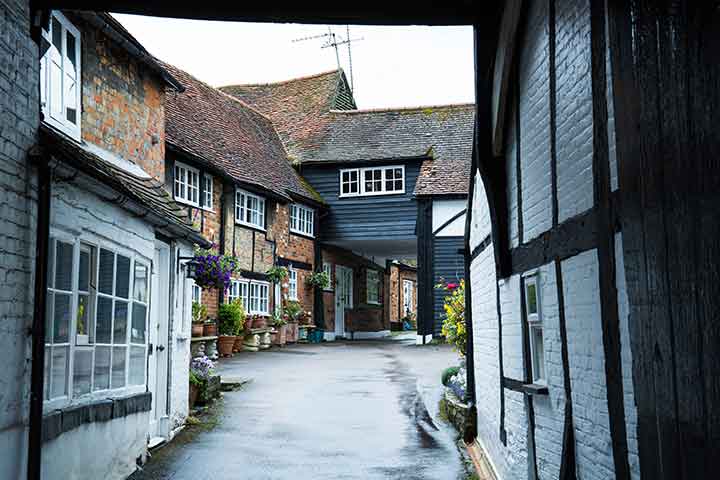Author, Derek Lester, gives a preview of his book about the historical importance of Chiltern Society site, the John Hampden monument
John Hampden’s monument at Prestwood was erected without ceremony on a date after the 17 June 1893 and before the 25 May 1895 to celebrate John Hampden’s stand against the King in what became known as the Ship-money trial.
The Ship-money trial that ended in 1637 with the judgement in the king’s favour reminded the Country that it was Parliament’s ancient right to raise taxes – ‘No taxation without representation’.
Note – Until 1885 Honor End, Prestwood, where the Monument stands, was an outpost of Stoke Mandeville, a Parish three miles from Great Hampden. In August 1863 a Press release was issued that read –
Memorial of John Hampden – Several gentlemen interested in preserving the memory of this great patriot, and among them the Lord Chief Justice Erle, have resolved to erect a monument in the field of Stoke Mandeville in which the levy for ship money was made which led to a contest ending in the Civil War. The work was entrusted to Mr. W. W. Thompson, of Aylesbury, and consists of a stone obelisk, eight feet high, surmounted by a Maltese cross, and bearing the following inscription:-
For these lands in Stoke Mandeville John Hampden was assessed in twenty shillings ship money, levied by command of the king, without authority of law, the 4th of August, 1635. By resisting the claim of the king in legal strife he upheld the rights of the people under the law, and became entitled to grateful remembrance. His work on earth ended after the conflict of Chalgrove Field, the 18th of June 1643, and he rests in Great Hampden Church. W.E. 1863.
The monument’s historical importance
John Hampden helped secure a Royal Charter for the Massachusetts Bay Company in 1628. In the early 1630s many residents from Prestwood, Great Hampden and the surrounding area left for a new life in Massachusetts, New England. The Rector of St Peter and St Paul’s church Great Missenden, Robert Lenthall Jnr was invited in 1637 to join his old parishioners in Weymouth, Massachusetts to be their Rector.
John Hampden was cast into the Tower’s Gatehouse in 1627 with Sir John Eliot for their refusal to pay a forced loan. While in the Tower they published a treatise on the ancient right of no taxation without representation. In 1629 the King tried to impose a Ship-money tax without Parliament’s consent but failed because of Eliot’s and Hampden’s objections. In 1629 the King prorogued Parliament and shortly after cast Sir John Eliot back into the Tower of London. It is recorded that Sir John Eliot died in the Tower in 1632. Evidence is accumulating that by some subterfuge Sir John Eliot escaped the Tower. Evidence is mounting that Sir John was taken to Boston, Massachusetts in 1632 aided by Hampden and his friends in New England; in later years Sir John became John Eliot the Apostle to the Indians.
In 1635 the King ordered payment of Ship Money on all of John Hampden’s estates. Ship-money tax was paid on all of Hampden’s estates except for an outpost of Stoke Mandeville; the place where the Monument now stands; in 1885 this outpost of Stoke Mandeville was incorporated into the Hampden Estate. In 1637 Hampden was found guilty for not paying Ship-money tax on his estate in Stoke Mandeville. John Hampden a firm supporter of Parliament’s ancient rights that he had learnt from Sir John Eliot and because of his stand against the King at the Ship-money trial became associated with phrase ‘No taxation without representation’.
In October 1765 at the Stamp Act Congress held in New York James Otis, a Boston Mass. lawyer, gave a speech using John Hampden’s name as an alias and here invoked the term ‘No taxation without representation’ in reference to Hampden’s stand against the King in 1635. This John Hampden was at the Boston Tea Party and also directed the troops throughout the American War of Independence. Following victory land was allocated to those who had given service to the War in what became known as the ‘Great Migration’. Hampden’s name was immortalised in that nine towns in New England were named after him.
August 22nd 1863 a national press release was issued that encompassed England, Ireland and Scotland which read – ‘Memorial of John Hampden – Several gentlemen interested in preserving the memory of this great patriot, and among them the Lord Chief Justice Erle, have resolved to erect a monument in the field of Stoke Mandeville in which the levy for ship money was made which led to a contest ending in the Civil War. The work was entrusted to Mr. W. W. Thompson, of Aylesbury, and consists of a stone obelisk, eight feet high, surmounted by a Maltese cross, and bearing the following inscription: –
For these lands in Stoke Mandeville John Hampden was assessed in twenty shillings ship money, levied by command of the king, without authority of law, the 4th of August, 1635. By resisting the claim of the king in legal strife he upheld the rights of the people under the law, and became entitled to grateful remembrance. His work on earth ended after the conflict of Chalgrove Field, the 18th of June 1643, and he rests in Great Hampden Church. W.E. 1863.’
William Erle served the 5th Earl of Buckinghamshire from 1825 as the family’s lawyer. Lord Chief Justice Erle is named to have presided at Aylesbury assizes in March 1863. The 1861 census has a Mr William Wendy Thompson, 2 Britannia Street, Aylesbury, a sculptor and mason of renown. The stonemason’s yard was located in a region of Aylesbury Market Square called Kingsbury. By August 22nd 1863 the monument was ready to be erected. It was intended for the cost of the Monument to be raised by subscription. Erle who initiated the project was called away before invitations to subscribe was arranged.
Throughout September and into October 1863 newspapers across Great Britain reprinted the Press release that a monument to honour John Hampden was to be raised. It is telling that not one of the hundreds of newspapers that issued the Press release headlined or made note of the Monument’s unveiling; it can safely be assumed the Monument was not raised in 1863.
Nothing more is read about the Ship-money monument until Robert Gibbs stated in Record of Local Occurrences published in 1882 that the monument was raised on the 11 Sept 1863. In the writing of Record of Local Occurrences Robert Gibbs’s, the proprietor of the Bucks Advertiser and Aylesbury News (1878-1882), had access to the newspaper’s archive. A detailed search of his newspaper, Bucks Advertiser and also the Bucks Herald of the 12 – 19th Sept 1863 failed to find a report of the raising of the Monument.
The Bucks Herald 18 November 1882 reported the following, ‘At Stoke Mandeville they found the very piece of land for which John Hampden refused to pay 40s ship money,’ referring to a group of erudite gentlemen. No mention of a monument. This is one of many reports of gentleman from 1863 through to 1893 visiting Great Hampden who did not find the ship money monument.
The Bucks Herald 17 June 1893 reported that the Norwood Athenaeum under the direction of Mr Renton visited the Earl of Buckinghamshire at Great Hampden on the 10 June 1893. Mr G H Lindsay-Renton published a report in the Upper Norwood Athenaeum Society’s magazine of their visit to Great Hampden June 10th 1893. Mr Renton described in eloquent terms objects of interest that were familiar to John Hampden the patriot and his stand against the king over Ship-money. Mr Renton gave an expressive description of the party of 64 gentlemen with the Earl walking down the Queen’s Gap; no mention of the ship money monument was made even though the party of well-informed gentlemen from the House of Lords were standing close by to where it would have been sited.
Bucks Herald 25 May 1895 – Local intelligence reported on Hazell, Watson and Viney’s Printing Works Outing to Great Hampden. During the visit Messrs. Jowett and A. Smith photographed the Hampden monument at Prestwood. The conclusion is the Monument was erected sometime between 17 June 1993 and 25 May 1895.
The monument was sculpted in 1863 and it is reasoned delivery was not made because the account was unsettled; the Ship-money monument became another piece stone in the mason’s yard. William W. Thompson’s wife Sarah died in 1869 and he, the sculptor of the monument sold the business, and in 1871 retired to Stapleford, Cambs. Aylesbury’s market square was redeveloped and the stonemason’s yard cleared and among the stone, it is presumed, was the Ship-money monument. The monument being only of value to Earl of Buckinghamshire found its way Great Hampden. The Earl, conscious that purchasing a ‘second-hand’ monument could damage his reputation had the monument erected without ceremony or of being reported in the local press.
John Hampden and the Battle of Chalgrove 1643, Derek Lester, Helion Press, 2023 is an assemblage of facts appertaining to John Hampden including a comprehensive account of Ship-money monument.
Book tickets for our talk and private viewing of the community exhibition John Hampden: A Wycombe Man with Global Impact, at Wycombe Museum HERE





